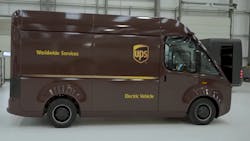Arrival slashes delivery targets, freezes bus program
Shares of electric commercial vehicle maker Arrival lost about a quarter of their value on Aug. 11 after executives said they are putting on ice their bus program and delaying plans to begin vehicle production to focus on building delivery vans at the company's plant in the United Kingdom.
Arrival’s leaders also sharply cut their 2022 delivery estimates to 20 units from their previous forecasts of 400 to 600 and said that, given those vehicles’ expected deliveries late in the year during UPS’ busy holiday season, they don’t expect to be paid for those until in early 2023. (UPS committed to buying 10,000 vans in early 2020, when the shipping giant's venture capital arm also invested in Arrival.)
See also: Turnkey charging infrastructure solution offers fleets an EV future at scaleOn a conference call with analysts, CEO Denis Sverdlov said the call “to focus on operating the business in a downscaled manner through at least 2023” was made to help the company deal with rising costs and ongoing supply chain problems as well as make its cash last longer. The retreat from earlier plans—which also includes delaying investments in hard tooling for its vans—will trim Arrival’s 2022 capital spending in the second half to a range of $40 million and $60 million. The company spent nearly $200 million in the first six months of the year, in line with its leaders' upbeat forecasts from late winter.
“We are focusing on one microfactory and one product running on one shift, which will be a critical enabler to our initial ramp, cost, and quality of production,” President Avinash Rugoobur said on the call.
Asked about the delay in setting up production in Charlotte, North Carolina—where the company’s early forecasts had hiring up to 800 people—the Arrival team declined to commit to a timeline for ramping it up but said they expect the facility to benefit from their experience in setting up Arrival’s plant in Bicester, northwest of London. Three months ago, Sverdlov and his lieutenants said they expected to start production in North Carolina during the fourth quarter.
In addition to slashing spending plans, Arrival’s executives also are looking to raise up to $300 million in the next year and a half via an at-the-market share sale program.
Arrival, which is formally headquartered in Luxembourg, posted a net loss of about $90 million and an adjusted EBITDA loss of $76 million in the second quarter. Both of those numbers were up substantially from the same period of 2021 and CFO John Wozniak said the company is now forecasting an EBITDA loss of $175 million to $195 million for the second half. The executive team now expects to end 2022 with cash on hand in the range of $210 million to $260 million before an expected $90 million from the stock sale program; their previous forecast had been for between $150 million and $200 million.
Arrival’s stock (Ticker: ARVL) was changing hands at about $1.40 on the afternoon of Aug. 11, down 24% from its close of the previous day. It lost 60% of its value in the past six months—and is down more than 90% since last November—trimming the company’s market capitalization to about $900 million.
About the Author
Geert De Lombaerde
Senior Editor
A native of Belgium, Geert De Lombaerde has more than two decades of experience in business journalism. Since 2021, he has written about markets and economic trends for Endeavor Business Media publications FleetOwner, Healthcare Innovation, IndustryWeek, Oil & Gas Journal, and T&D World.
With a degree in journalism from the University of Missouri, he began his reporting career at the Business Courier in Cincinnati. He later was managing editor and editor of the Nashville Business Journal. Most recently, he oversaw the online and print products of the Nashville Post and reported primarily on Middle Tennessee’s finance sector and many of its publicly traded companies.

